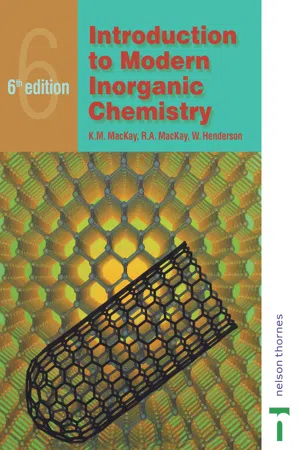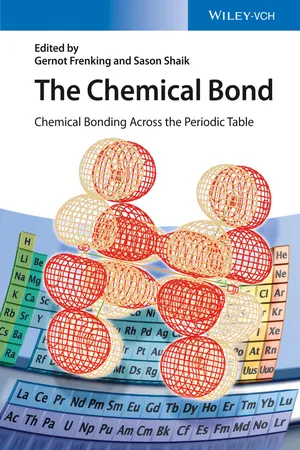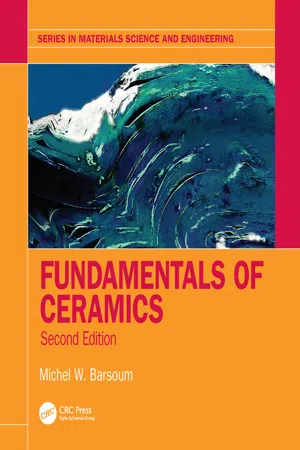Chemistry
Ionic Solids
Ionic solids are a type of crystalline solid composed of positively and negatively charged ions held together by electrostatic forces. They have high melting and boiling points due to the strong ionic bonds. Ionic solids are typically brittle and non-conductive in their solid state, but conduct electricity when melted or dissolved in water due to the mobility of the ions.
Written by Perlego with AI-assistance
Related key terms
Related key terms
1 of 4
Related key terms
1 of 3
7 Key excerpts on "Ionic Solids"
- R.A. Mackay(Author)
- 2017(Publication Date)
- CRC Press(Publisher)
Finally we may pick out the class of metals which are related to the giant molecules but where the outer electrons are free to move throughout the crystal. Such crystals show a range of hardness and melting points, and are highly reflecting and conducting.These four classes are idealized cases and a range of interactions apply in most solids (compare also the discussion based on Fig. 5.11 in Section 5.6 ). We start this chapter with ionic crystals, where the basic interactions are well understood, and we go on to relate other types of solid to these.Simple ionic crystals
5.1 The formation of ionic compounds
In the last two chapters, the Lewis electron pair theory was extended on the basis of wave mechanics to give a full description of the covalent bond. In this section, ionic bonding will be examined and the various factors which determine the formation and stability of ionic compounds will be discussed.The basic process in the formation of an ionic compound is the transfer of one or more electrons from one type of atom to another: the resulting ions are then held together by electrostatic attraction.Isolated ionic species, such as the two-atom entity M+ X – , do not exist under ordinary conditions. In ionic compounds, we are dealing with an array of ions, which extends in three dimensions to the edges of the crystallite. If the ionic solid dissolves, the ions are indeed separated, but they are stabilized by interaction with the solvent molecules (see Chapter 6 ) and the free ion has only a transient existence.The arrangement of the ions in the solid is the one which gives the highest electrostatic energy. To see what factors determine this arrangement, consider the process of bringing up successive anions around a given cation. If there are already π anions surrounding the cation, the addition of a further anion produces an extra attraction between its charge and the cation charge, and also produces a number of repulsions between its charge and the charges on the π- eBook - ePub
Solid State Chemistry
An Introduction
- Elaine A. Moore, Lesley E. Smart(Authors)
- 2020(Publication Date)
- CRC Press(Publisher)
https://www.ngk.co.jp/nas/ )While many of the batteries we look at have solid electrodes, the electrolyte is a liquid solution. The electrolyte in solid-state batteries is a solid. To be useful as a solid electrolyte, the conducting solid must have a high ionic conductivity, but it must be an electronic insulator, so that it can separate the two reactants of the device allowing only ions, and not electrons, to travel through the solid—or the device would short-circuit. Before we consider individual batteries, we shall first look at ionic conductivity in solids and the types of solid that are good ionic conductors. We then describe some important types of batteries.6.2 Ionic Conductivity in Solids
Ionic conductivity , that is, ion transport under the influence of an external electric field, is made possible by the presence of point defects (Chapter 5 ). Two possible mechanisms for the movement of ions through a lattice are sketched in Figure 6.4 . In Figure 6.4a , an ion hops or jumps from its normal position on the lattice to a neighbouring equivalent but vacant site. This is called the vacancy mechanism (it can equally well be described as the movement of a vacancy rather than the movement of the ion). Figure 6.4b shows the interstitial mechanism , where an interstitial ion jumps or hops to an adjacent equivalent site. These simple pictures of movement in an ionic lattice are known as the hopping model - eBook - ePub
- Jeffrey Gaffney, Nancy Marley(Authors)
- 2017(Publication Date)
- Elsevier(Publisher)
Fig. 11.8 . At 420 K, the silver iodide crystal structure changes from the close packed face-centered cubic to a more open body-centered cubic form. The iodide ions still occupy the lattice points and the silver ions still occupy tetrahedral voids. But, since the high temperature body-centered cubic form is not a close packed structure, it has many more voids than the close packed face-centered cubic form. The voids include 12 tetrahedral voids (24 voids shared with 2 cells), 6 octahedral voids, and an additional 24 tetragonal voids. The high temperature coupled with the more open structure of the body-centered form allows the 2 silver ions per unit cell to move rapidly between any of these 42 voids. This gives the silver ions a very high mobility in the crystal structure, resulting in the anomalously high electrical conductivity. So, the high conductivity of the solid silver iodide in the high temperature body-centered cubic lattice is a result of the large cationic radius of the iodide anion, which is restricted to the lattice points maintaining the rigid solid structure, and the high mobility of the small silver ion, which is allowed to move freely between the 42 voids in the open structure. This phenomenon is referred to as fast ion conduction.Fig. 11.8 The available tetrahedral voids in the close packed face-centered cubic (left) and the open body-centered cubic (right) unit cells.This high temperature phase of silver iodide was the firstfast ion conductorever discovered. Fast ion conductors function as solid electrolytes. They possess the rigidity of solids with a disorder on the atomic scale similar to a liquid. This has sometimes been referred to as a “molten sublattice.” Other fast ion conductors are the silver halides: AgBr and AgCl, the copper halides: CuI, CuBr, and CuCl, and silver compounds from anions in group 16 of the periodic table: Ag2 S, Ag2 Se, and Ag2 Te. Fast ion conductors are used in solid state supercapacitors, batteries, solid oxide fuel cells, and in chemical sensors as ion carriers.11.3 Molecular Solids
Molecular solids are composed of atoms or molecules held together by intermolecular forces. The constituent species of molecular solids are molecules except in the solidified noble gases, where the units are atoms. While the bonding within the molecules is covalent and strong, the forces which hold the molecules together in the crystal lattice are the weak intermolecular forces discussed in Section 3.8 . These include: dipole-dipole forces, London dispersion forces, and hydrogen bonding. There are three types of molecular solids, which are classified according to the type of intermolecular force involved: nonpolar molecular solids, polar molecular solids, and hydrogen-bonded molecular solids. Molecular solids form crystals where the molecules tend to pack in a way that maximizes the intermolecular forces. So, the way that the molecules are arranged in the crystal lattice depends upon the shape of the molecules and the types of intermolecular forces involved.Nonpolar molecular solids are composed of atoms of the noble gases, nonpolar diatomic molecules, or nonpolar organic molecules. The attractive force that holds them together in the solid form is the weak London dispersion forces. Because the forces between the molecules are very weak, very few nonpolar molecular solids exist in solid form at room temperature and pressure. The solid form can only be observed at very low temperatures and they frequently sublime, going directly from the solid phase to the gas phase without passing through the liquid phase. - eBook - ePub
The Chemical Bond
Chemical Bonding Across the Periodic Table
- Gernot Frenking, Sason Shaik(Authors)
- 2014(Publication Date)
- Wiley-VCH(Publisher)
15 Chemical Bonding in SolidsPere Alemany and Enric Canadell15.1 Introduction
Having a good grasp of the factors determining the structure and properties of solids is a challenging task that needs inputs from both physical chemistry and condensed matter physics. Solids can be simply seen as giant molecules and thus one is tempted to conclude that the same ideas and concepts used in molecular chemistry should lie behind our understanding of solids at the atomic level. Nevertheless, the large size of a solid as compared to that of single molecules brings about new collective features that are at the basis of many of their technological applications. This means that our approach to solids must be based on a scheme that, while keeping strong ties with the more or less local view of chemical bonding in molecules, should also incorporate the essentially delocalized approach used in condensed matter physics to understand the origin of these collective properties.Among the different possible classifications of solids, it is quite usual to distinguish them according to the main cohesive forces keeping the atoms or molecules together. The four types of solids described in the introductory chapters of any solid state chemistry textbook are ionic, molecular, covalent, and metallic solids [1–3]. Molecular solids are composed from individual atoms or molecules that retain their individuality and are kept together by weak van der Waals forces, in the case of nonpolar constituents, or more directional electrostatic forces such as dipole–dipole interactions or hydrogen bonding, for more polar constituents. In Ionic Solids, the electrostatic interactions are assumed to provide the leading cohesive force. Of course, a purely ionic bond does not occur; between any pair of bonded species some degree of electron sharing, that is, covalence, occurs. However, when the electronegativity difference between constituents is considerable, an ionic model leads to useful organizing structural principles such as the Goldschmidt and Pauling rules [4]. When the electronegativity differences decrease, covalent bonding takes the lead. In contrast, in the case of ionic bonding, a satisfactory approach to covalent bonding needs the use of a quantum mechanical treatment. Valence bond and molecular orbital (or its solid state counterpart crystal orbital) approaches have been used to develop our understanding of covalent bonding in solids. Although both approaches can be made equivalent at the limit, and the use of one or the other is often a question of preference, the second has been more popular probably because of its simplicity and easiness to correlate the structural and electronic details even for quite complex structures. The bonding in covalent solids and molecules is governed by the same rules. In particular, a localized description in terms of electron pairs either as chemical bonds and/or lone pairs is conceptually possible although a more delocalized description may be more informative. Finally, when such a localized description is no more possible and the electrons are delocalized among many atoms, we deal with metallic bonding. In contrast to the common belief, this situation is not peculiar of solids; bonding in some discrete transition-metal clusters or electron-deficient molecules has exactly the same origin. In metallic solids, the electrons are delocalized throughout the whole solid and require the delocalized quantum mechanical description of band theory. - eBook - ePub
- Anthony R. West(Author)
- 2014(Publication Date)
- Wiley(Publisher)
3 Bonding in Solids 3.1 Overview: Ionic, Covalent, Metallic, van der Waals and Hydrogen Bonding in SolidsCrystalline materials exhibit the complete spectrum of bond types, ranging from ionic to covalent, van der Waals and metallic. Sometimes more than one type of bonding is present, as in salts of complex anions, e.g. Li2 SO4 , which have both ionic bonds between Li+ and SO4 2– ions and covalent bonds linking sulfur and oxygen atoms within SO4 2– ions. Commonly, the bonds are a blend of different types, as in TiO, which is ionic/metallic, and CdI2 , which is ionic/covalent/van der Waals. In discussing structures, it is often convenient to ignore temporarily the complexities of mixed bond types and to treat bonds as though they were purely ionic.Ionic bonding leads to structures with high symmetry in which the coordination numbers are as high as possible. In this way, the net electrostatic attractive force which holds crystals together (and hence the lattice energy) is maximised. Covalent bonding , by contrast, gives highly directional bonds in which atoms prefer a certain coordination environment, irrespective of other atoms that are present. The coordination numbers in covalent structures are usually small and may be less than those in ionic structures which contain similar-sized atoms.The bonding in a particular compound correlates fairly well with the position of the component atoms in the periodic table and, especially, with their electronegativity. Alkali and alkaline earth elements usually form ionic structures (Be is sometimes an exception), especially in combination with small electronegative anions such as O2− and F− . Covalent structures occur especially with (a) small atoms of high valency which, in the cationic state, would be highly polarising, e.g. B3+ , Si4+ , P5+ and S6+ and to a lesser extent with (b) large atoms which in the anionic state are highly polarisable, e.g. I− and S2− . Most non-molecular materials have mixed ionic and covalent bonding and, as discussed later, it is possible to assess the ionicity - eBook - ePub
- Michel Barsoum(Author)
- 2019(Publication Date)
- CRC Press(Publisher)
Table 2.3 —was obtained by arbitrarily fixing the value of H at 2.2. With this scale, it becomes relatively simple to predict a bond's nature. If two elements forming a bond have similar electronegativities, they will tend to share the electrons between them and will form covalent bonds. However, if the electronegativity difference, ΔX, between them is large (indicating that one element is much greedier than the other), the electron will be attracted to the more electronegative element, forming ions which, in turn, attract each other. Needless to say, the transition between ionic and covalent bonding is far from sharp and, except for homopolar bonds that are purely covalent, all bonds will have both an ionic and a covalent character (see Prob. 2.16). However, as a quite rough guide, a bond is considered predominantly ionic when ΔX > 1.7 and predominantly covalent if ΔX < 1.7.TABLE 2.3 Relative electronegativity scale of the elements Each type of bond and how it leads to the formation of a solid is discussed separately below, starting with the simpler of the two, namely, the ionic bond.2.4 Ionic Bonding
Ionically bonded solids are made up of charged particles—positively charged ions, called cations , and negatively charged ions, called anions. Their mutual attraction holds the solid together. Ionic bonds are omnidirectional. Ionic compounds are typically hard and brittle and are poor electrical and thermal conductors.To illustrate the energetics of ionic bonding consider the bond formed between Na and Cl. The electronic configuration of Cl (atomic number Z = 17) is [1s2 2s2 2p6 ]3s2 3p5 , while that of Na (Z = 11) is [1s2 2s2 2p6 ]3s1 . For reasons that will become evident in a moment, when Na and Cl atoms are brought into close proximity, a bond will form by the transfer of an electron from the Na atom to the Cl atom, as shown schematically in Fig. 2.3 . The Na atom configuration becomes [1s2 2s2 2p6 ] and is now +1 positively charged; the Cl atom gains an electron, acquires a –1 negative charge, and its electronic structure becomes [1s2 2s2 2p6 ]3s2 3p6 . Note that after the charge transfer, the configuration of the Na and Cl ions correspond to those of the noble gases, Ne and Ar, respectively.FIGURE 2.3 (a ) Electron transfer from a Na atom to Cl atom results in the formation of, (b - eBook - ePub
- Mihkel Koel(Author)
- 2016(Publication Date)
- WSPC (EUROPE)(Publisher)
U dominates the energetics of the system leaving the entropy as supporting actor. The motion of the molecules now shows a strong vibrational and weak translational and rotational character.The transition from liquid to solid state is a subtle process. Sometimes, the situation is even more complex. For example, the liquid phase may be followed by a glassy state. Therefore, in physics, the term “soft matter” is in use which comprises a manifold of condensed matter: liquids, colloids, polymers, foams, gels, plastic crystals, granular materials and a number of biological materials, which are easily deformed by thermal stresses or strongly influenced by thermal fluctuations (Kleman and Lavrentovich, 2003). These materials share an important common feature in that predominant physical behaviour occurs at an energy scale comparable with room-temperature thermal energy. The present work focuses on a special topic of soft matter: molecular ionic liquids (ILs).As a simple definition given by Paul Walden in 1914, ILs are commonly recognised as salts with a melting point below 100°C (Plechkova and Seddon, 2008). Popular cations are imidazoliums, but other organic heterocyclic cations such as pyridinium or pyrrolidinium are also possible. In addition, ammonium, phosphonium and sulfonium cations with linear, branched or functionalised side chains have been used. Typical anorganic anions comprise halides, alkylsulfates, alkylsulfonates and in particular bis(trifluoromethylsulfonyl)imide (see Fig. 1.1 ).The plethora of cation/anion combinations allows for variation of the physico-chemical properties over a very broad range and can be further fine-tuned by side chain modifications of both cations and anions. However, many physico-chemical properties of ILs are correlated to their molecular volumeVm= M · ρ −1 ·NA(see Fig. 1.2 ) which can be easily evaluated since the molar mass M and the mass density ρ are available for numerous ILs. The decomposition into the cationic and anionic contribution of as well as the computation ofVmof an unknown IL compound are also feasible using statistical approaches (Bica et al ., 2013). Typical values are given in Table 1.1 which are similar to those proposed by Krossing et al . (2006). The following discussion of physico-chemical properties of ILs will focus on the dependence on the length of the alkyl side chains of imidazolium-based ILs since most experimental data exist on this class of ILs. Naturally, prolonging the chain length n increasesVm
Index pages curate the most relevant extracts from our library of academic textbooks. They’ve been created using an in-house natural language model (NLM), each adding context and meaning to key research topics.
Explore more topic indexes
Explore more topic indexes
1 of 6
Explore more topic indexes
1 of 4






